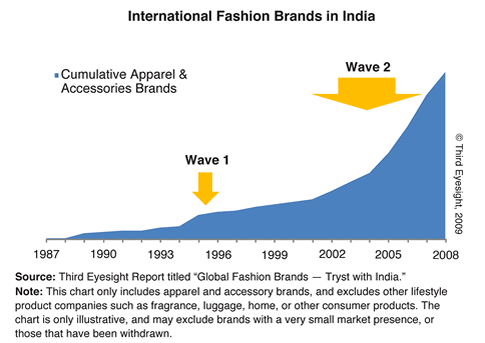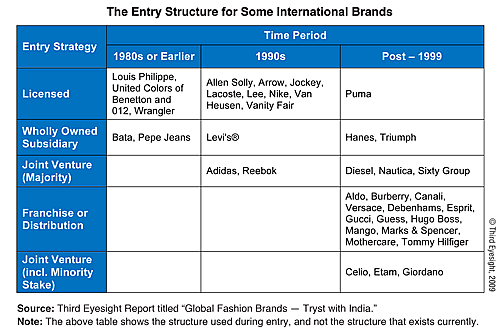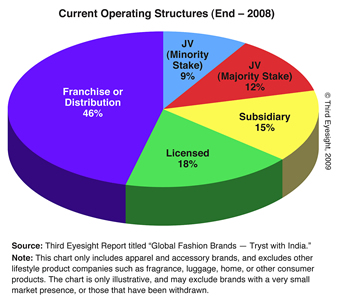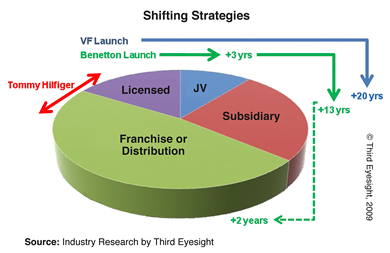 Devangshu Dutta
Devangshu Dutta Tarang Gautam Saxena
Tarang Gautam SaxenaThird Eyesight is a consulting firm focused on retail and consumer products that supports international and Indian companies through pragmatic research and strategy development, evaluating and developing alliances, and implementation support. This article is based on a more detailed report prepared by the Third Eyesight team (www.thirdeyesight.in) titled “Global Fashion Brands: Tryst with India.” Inquiries about the report can be e-mailed to services@thirdeyesight.in.
While Indian consumers have aspired to own international fashion brands, India’s large population base has been in turn an aspirational market for international companies.
To remote observers, the Indian market may appear to be virgin territory as far as international apparel and footwear brands are concerned. But India has seen the presence of international brands for almost a century, including mass brands such as Bata and luxury brands such as Louis Vuitton. However, as the colonial government systematically repressed local textile production, local resistance to foreign products grew as well. Therefore, until the 1980s, the presence of international fashion brands was negligible.
In the early 1990s, as the Indian economy opened up again, a few international fashion brands entered the Indian market. The pioneering companies during this stage were Benetton, Coats Viyella, and VF Corporation. At this time, the Indian apparel market was still fragmented, with multiple local and regional labels and very few national brands. Ready-to-wear apparel was prevalent primarily in the menswear segment, which thus became a target for many international fashion brands (such as Louis Philippe, Arrow, Allen Solly, Lacoste, adidas, and Nike).
 In the midst of this, the media industry in India was also experiencing high growth, which aided the international brands in gaining visibility and establishing brand equity in the Indian market.
In the midst of this, the media industry in India was also experiencing high growth, which aided the international brands in gaining visibility and establishing brand equity in the Indian market.
The late 1990s marked a significant milestone in the growth of modern retail in India. Higher disposable incomes and the availability of credit significantly enhanced consumers’ buying power. A growing supply of good-quality retail real estate in the form of shopping centers and large-format department stores also allowed companies to create a more complete brand experience through exclusive brand stores and shops-in-shop.
The number of international brands continued to grow each year at a steady pace until the early 2000s and took off exponentially thereafter. By 2005 the number of international fashion brands present in India was more than three times that in the mid-1990s. The last few years (since 2005) have continued to see significant growth of international fashion brands, including luxury brands such as LVMH, Aigner, Tommy Hilfiger, and Chanel.

Many of the international companies entering India in the late 1980s and 1990s chose licensing as their entry route to India to gain quick access to the Indian market at a minimal investment. A few companies such as Levi Strauss set up wholly owned subsidiaries, while others such as adidas and Reebok entered into majority-owned joint ventures. This helped them to gain greater control over their Indian operations, sourcing and supply chains, and brands.
In the subsequent years, import duties for fashion products successively came down, making imports a less expensive sourcing option, and the realty boom brought investors in retail real estate that were ideal franchisees for the international brands. By 2003, franchising became the preferred launch vehicle for an increasing number of international companies, while only a few chose to enter through licensing.
In 2006, the government of India reopened retail to foreign investment (allowing up to 51 percent foreign direct investment in “single brand” retail). Using this route, many brands have entered India by setting up majority-owned joint ventures, or they have transitioned their existing franchise arrangements into a joint venture structure.

By the end of 2008, just under half of the brands were present through a franchise or distribution relationship, while over a quarter had either a wholly owned or majority owned subsidiary. These structures allowed the brands to have greater control of operations, particularly of product.
Shifting Strategies
Many international companies have evolved their presence in India into structures different from those at the time they entered the market.
A good example depicting this shift in business strategy is VF Corporation, which entered India in the1980s by assigning the Wrangler license to Dupont Sportswear. Since then it has launched a variety of brands in different product categories with a number of Indian partners and finally formed a joint venture, VF Arvind Brands Pvt. Ltd., with Arvind Brands.
Another example of a company that has evolved its presence is Benetton, which first entered India through a licensee (Dalmia). Benetton then transitioned in 1991 into a 50-50 joint venture, and finally in 2004 took over the Indian business completely. However, it adopted the franchising route in 2006 for its premium fashion brand, Sisley, appointing Trent (a Tata Group company) as the national retail franchisee.

Many other companies such as Nike, Tommy Hilfiger, Marks & Spencer, and Pierre Cardin (as described in our report “Global Fashion Brands: Tryst with India”) have changed their approach as the original structures did not perform as well as they had expected.
Obviously, each of these changes in strategy has cost the brands time, management effort, money and, sometimes, market share. We believe that these shifts and the pain related to them could have been reduced had the brands ruthlessly questioned their motivation for considering this market and their expectations from the market in determining an appropriate strategy.
What’s Ahead?
In the midst of economic upheaval around the world, how does India look as a market for international fashion brands? It is difficult to generalize even in the best of times, and in the current global turmoil there is certainly a lot more unpredictability about international expansion for most companies.
Although India’s position as a target market for international brands has been improving, as is evident from the number of launches in the last six to seven years, some companies considering international expansion may prefer entering other markets that may seem more “familiar,” developed, and safe (such as Europe, Japan, South Korea, or Taiwan). Against such comparisons, India’s growing but fragmented market can seem chaotic and difficult to deal with.
However, the fact remains that there are very few markets globally that can provide the sustained size of mid-term and long-term opportunity that India does. We are already seeing the more far-sighted and committed brands consolidating their position and presence in the market by continuing to look at expansion, even while examining how they can make their existing points of sale perform better. We also constantly come across new companies carrying out investigations into the market.
In the current environment we expect to see a shift in the nature of the launch vehicle. While franchising seems to be a safe option for risk-averse brands in the current times, we will probably see more brands with a long-term strategy establishing a controlled presence either through joint ventures or through wholly owned subsidiaries, because they can lay the foundation of the business today at much lower costs than in the past few years.
India’s foreign direct investment (FDI) policy, allowing FDI only up to 51 percent in retail trading of a single brand, may have held back some fashion brands that are still managed by owner founders with a conservative outlook on control. However, in the last couple of years, we have found companies not being deterred by the barriers to FDI.
As their comfort and familiarity with India has grown, international companies are more willing now to create corporate structures that allow them a presence in the market today and a step-through to a more controlling stake when government regulations allow. All in all, we feel that international brands are in India not only to stay but also to expand. There is yet a lot of untapped potential in the market, and as the integration of the Indian consumer with global trends continues, international brands can expect to find India an increasingly fertile ground for growth.